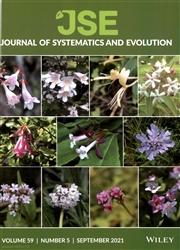杂交结缕草:利用遗传学、细胞学和形态学数据区分法国东北部的亚洲结缕草
IF 2.9
1区 生物学
Q1 Agricultural and Biological Sciences
引用次数: 0
摘要
两种入侵的栗树(Reynoutria japonica var. japonica 和 Reynoutria sachalinensis)及其杂交种 Reynoutria x bohemica 经常被管理人员和非专业人员误认。引入种群在形态、遗传多样性和倍性水平方面的种下变异更加剧了分类上的混乱。我们利用 RADseq 分析得出的 4582 个单核苷酸多态性(SNPs)、流式细胞仪估算的 DNA 含量以及 12 个无性系形态变量,确定了法国东北部入侵种群的身份。这些 SNPs 只支持 11 个地方的 R. japonica 的一个单一基因型,而 Reynoutria x bohemica 的 9 个地方各有一个基因型。使用 DAPI 染色和流式细胞仪估算基因组大小时发现,R. japonica 只有八倍体细胞型,R. x bohemica 有六倍体细胞型,而 R. sachalinensis 则有四倍体和六倍体细胞型。在形态计量变量中,没有一个变量能明确区分这三个类群。我们根据叶片和顶端长度、叶片形状、叶基部和顶端形状以及节上的花外蜜腺等六个无性系标准,提出了一种特征组合,以方便快捷地识别这三个入侵类群。本文章由计算机程序翻译,如有差异,请以英文原文为准。
A knot of hybrids: Differentiating Asian knotweeds in North‐Eastern France using genetic, cytological, and morphological data
The two invasive Reynoutria species, Reynoutria japonica var. japonica and Reynoutria sachalinensis , and their hybrid Reynoutria x bohemica are often misidentified by managers and nonspecialists. The taxonomic confusions are all the more exacerbated by the infraspecific variability of introduced populations in terms of morphology, genetic diversity, and ploidy level. We resolved the identity of North‐Eastern French invasive populations using 4582 single‐nucleotide polymorphisms (SNPs) from a RADseq analysis, DNA contents estimated by flow cytometry, and 12 vegetative morphometric variables. The SNPs supported only one single genotype for R. japonica over 11 localities, while the nine localities of Reynoutria x bohemica were represented by one genotype each. Estimation of genome size using DAPI staining and flow cytometry revealed only octoploid cytotypes for R. japonica and hexaploid cytotypes for R . x bohemica , whereas R. sachalinensis was represented by tetraploid and hexaploid cytotypes. Among morphometric variables, no single one allows for a clear differentiation of the three taxa. We propose a combination of characters to easily and quickly identify these three invasive taxa based on six vegetative criteria including leaf and apex length, as well as leaf shape, leaf base, and apex shape, and the extrafloral nectaries on the node.
求助全文
通过发布文献求助,成功后即可免费获取论文全文。
去求助
来源期刊

Journal of Systematics and Evolution
Agricultural and Biological Sciences-Ecology, Evolution, Behavior and Systematics
CiteScore
7.40
自引率
8.10%
发文量
1368
审稿时长
6-12 weeks
期刊介绍:
Journal of Systematics and Evolution (JSE, since 2008; formerly Acta Phytotaxonomica Sinica) is a plant-based international journal newly dedicated to the description and understanding of the biological diversity. It covers: description of new taxa, monographic revision, phylogenetics, molecular evolution and genome evolution, evolutionary developmental biology, evolutionary ecology, population biology, conservation biology, biogeography, paleobiology, evolutionary theories, and related subjects.
 求助内容:
求助内容: 应助结果提醒方式:
应助结果提醒方式:


